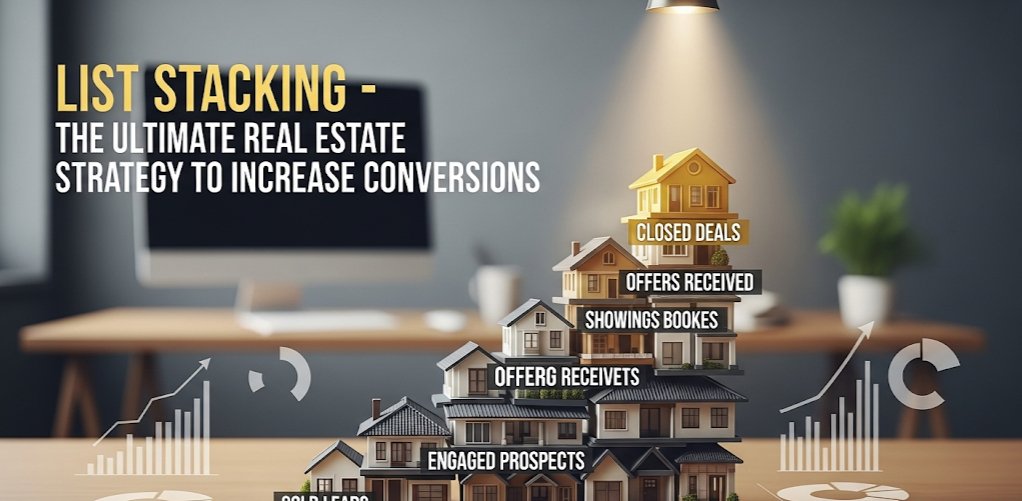In real estate, not all leads are created equal. Some people are just curious. Others are facing serious financial issues and desperately need a solution. The key to more deals and better marketing results is being able to tell the difference. That’s where list stacking enters the picture as one of the most powerful tools available to real estate professionals today.
List stacking is more than a marketing trick. It’s a strategic advantage that helps you identify people who are more likely to sell, based on the problems they’re experiencing. By using list stacking, investors stop wasting time on cold leads and start focusing on the ones who actually need help.
What Is List Stacking and Why Should You Care?
List stacking is a process where real estate investors combine multiple lead lists to find individuals or properties that appear on more than one list. The more lists a person appears on, the higher the likelihood they are going through distress or some form of motivation to sell.
Think about it. If a homeowner is behind on property taxes, has a vacant home, and is also in pre-foreclosure, they’re far more likely to entertain a conversation about selling than someone who just inherited a property but has no financial pressure. List stacking helps you filter out the noise and focus on the signals that actually matter.
This technique saves time, increases response rates, and boosts return on investment. It transforms how you approach your lead generation, turning cold outreach into laser-focused conversations with people who truly need solutions.
How List Stacking Works in Real Life
To implement list stacking, you need access to multiple types of real estate lead data. This could include lists of absentee owners, tax delinquent properties, pre-foreclosures, probate properties, code violations, and more. By collecting this data from various sources, you begin to see patterns. Certain names and addresses show up across more than one list. These are your high-priority leads.
Instead of working through one large list of general contacts, you shift your focus toward people who appear on two, three, or more lists at once. That level of overlap means they are experiencing multiple issues and may be more open to hearing from you.
Let’s say you’re marketing to homeowners in Dubai. You have one list of owners who haven’t updated their Ejari registration. You have another list of people behind on utility payments. And another list showing vacant or non-occupied units. When someone shows up on all three, it’s not just coincidence. It’s a sign of potential distress that could lead to a sale.
Why List Stacking Changes the Game for Investors
The biggest advantage of list stacking is that it gives you better targeting. Traditional lead generation is often a numbers game. You buy a list, send out thousands of postcards or messages, and hope for a response. But most of the people you contact aren’t interested in selling or aren’t motivated to act.
With list stacking, you flip that equation. You start with the most motivated sellers, those experiencing multiple challenges. This means your messaging is more relevant, your timing is better, and your overall conversion rate improves. Instead of spending your budget on thousands of indifferent leads, you invest in a much smaller group of high-quality opportunities.
This approach makes your marketing smarter, your time more productive, and your deals more consistent. It’s not about working harder — it’s about working more intelligently.
The Data Behind Effective List Stacking
List stacking works best when the data you use is clean, accurate, and well-organized. That means ensuring all names, addresses, and contact details are formatted consistently. It also means removing duplicates and verifying ownership where possible.
Once your lists are in good shape, you can begin to stack them. This is where automation platforms come in handy. Instead of trying to sort spreadsheets manually, software can automatically scan for overlaps and give you a priority ranking based on how many lists each lead appears on.
This scoring process helps you segment your outreach. A lead that appears on three or more lists goes to the top of the funnel. Leads on two lists might get follow-up messages, while those on only one list are placed in a long-term nurture sequence. With this system in place, you’re always targeting the people who are most likely to engage.
How List Stacking Fits into Your Marketing Funnel
Once you’ve built your stacked list, it’s time to reach out. The beauty of list stacking is that it gives you context. Instead of guessing what problem a lead might be facing, you already have a pretty good idea.
If someone appears on a delinquent mortgage list and a code violation list, your messaging can address both. You can offer solutions that speak to their exact situation, making your message feel personalized instead of generic.
This leads to better response rates, higher engagement, and more trust from the start. Instead of cold calling or mailing random homeowners, you’re having conversations with people who already feel understood.
And because your list is smaller but more qualified, you can afford to spend more per lead. That means better mailers, more time on calls, and more thorough follow-ups — all of which increase your chances of converting leads into deals.
The Role of Automation in List Stacking
While list stacking can be done manually with spreadsheets, automation makes the process far more efficient. Tools like StreamlineREI offer real estate automation systems specifically built for lead management and stacking. These platforms allow you to import multiple lead lists, clean the data, identify overlaps, and assign scores to leads based on their stack depth.
The real power of automation isn’t just in organizing the data. It’s in what comes next. Once your stacked leads are sorted, the software can automatically launch outreach campaigns. You can set workflows for text messaging, email follow-ups, direct mail drops, or cold calling schedules. Everything becomes streamlined.
That level of automation lets you scale your efforts without losing the precision that list stacking provides. It also keeps your pipeline full of motivated sellers while reducing the time you spend on manual tasks.
Localizing List Stacking for the UAE Market
In the United Arab Emirates, list stacking is starting to gain traction among local and international investors alike. As Dubai’s real estate sector becomes more data-driven, the need for efficient targeting is rising.
UAE investors can adapt list stacking by using data such as Ejari renewal lapses, utility arrears, property vacancy reports, expired listings, and ownership records. Identifying properties owned by non-residents, landlords with multiple code violations, or units held long-term without rental income can reveal high-motivation leads.
Using this localized data and applying the principles of list stacking can help investors close more off-market deals, reduce competition, and boost their marketing performance in a growing and competitive market.
Common Challenges When Starting List Stacking
One of the biggest challenges investors face when trying to implement list stacking is access to quality data. Not all data providers are equal. Some lists are outdated, inaccurate, or missing key contact information. Investing in reliable data sources is critical.
Another challenge is cleaning and organizing the data. This step is often overlooked, but messy spreadsheets can ruin your stacking efforts. Names must match, addresses must be standardized, and duplicates must be removed for the stack to work correctly.
Finally, some investors struggle with follow-through. Stacked leads are powerful, but only if you take action. Having a solid follow-up system and dedicated outreach strategy ensures that you’re not just collecting leads — you’re closing deals.
Why Every Investor Should Embrace List Stacking
Real estate is about timing, targeting, and trust. list stacking real estate helps you hit all three. By narrowing your focus to the most distressed and motivated sellers, you reach people at the right time, with the right message, and in the right way.
That level of precision is hard to achieve with traditional mass marketing. You’ll stop wasting resources and start seeing real results. Whether you’re a solo wholesaler or running a large team, list stacking adds a layer of intelligence to your business that other investors simply don’t have.
It’s not a secret weapon. It’s a smart strategy that rewards effort, organization, and consistency.
The Future of Real Estate Lead Generation
As the market becomes more saturated and data becomes more accessible, simply buying a lead list won’t cut it. Smart investors will need to refine their processes and maximize every point of contact.
List stacking isn’t just a short-term hack. It’s part of a larger shift toward intelligent marketing. It allows you to filter through massive amounts of data and find the handful of people who actually want and need your help.
When you approach marketing with that mindset, everything changes. Your conversations become more natural. Your offers become more valuable. Your business becomes more predictable and scalable.
Frequently Asked Questions About List Stacking
What exactly is list stacking in real estate?
List stacking is the process of layering multiple lead lists to find people who appear on more than one. This helps investors identify highly motivated sellers by focusing on those who are facing multiple challenges or distress factors.
Why is list stacking more effective than using a single lead list?
Using a single list casts a wide net but often includes many low-quality leads. List stacking allows you to filter and focus on the leads who show up across multiple lists, increasing the chance that they are motivated and ready to sell.
Can I do list stacking without expensive software?
Yes, list stacking can be done using spreadsheets, but it requires a lot of manual work. For investors handling large volumes of data, automation tools like StreamlineREI are more efficient and accurate.
How often should I update my list stacking data?
It’s recommended to update your lead lists monthly. Fresh data ensures that your targeting remains accurate and relevant, and helps you respond quickly to new distress signals.
Is list stacking only for wholesaling and off-market deals?
No. List stacking benefits anyone in the real estate industry who relies on finding motivated sellers, including flippers, buy-and-hold investors, and even real estate agents looking for listings.
What makes a good lead stack?
A good stack includes clean data, multiple types of distress indicators, and clear identification of overlaps. The most powerful stacks involve leads that show up on at least two or three lists and have supporting signs of financial or property-related hardship.







